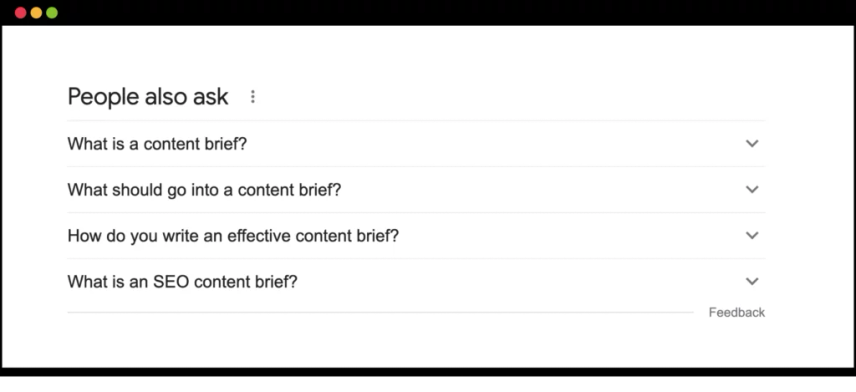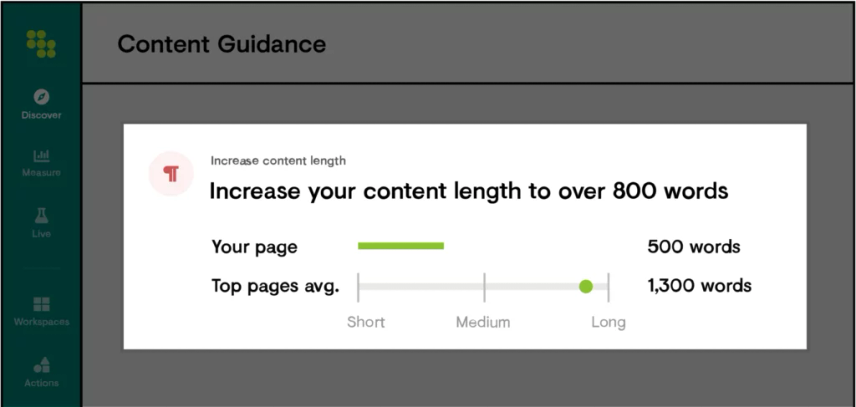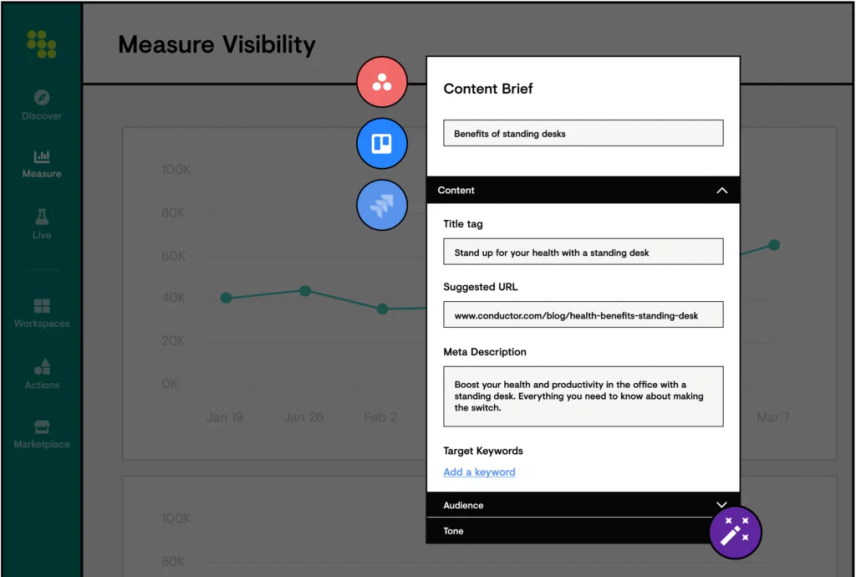Your Guide to an Effective SEO Content Brief
Learn how to create killer SEO content briefs that will boost your content, foster collaboration, and streamline your processes.
Consider this: you find an opportunity to create content around queries that are on-brand, have high search volumes, and low competitionCompetition
Businesses generally know who their competitors are on the open market. But are they the same companies you need to fight to get the best placement for your website? Not necessarily!
Learn more. You provide a writer with a list of target keywords and a piece of competitor content to serve as inspiration. However, the content your writer brings back completely misses the mark. This leads to a string of rewrites, wasting precious time and the resulting piece still reads like a jumbled mess. Back to the drawing board you go. All of this could have been solved with a strong SEO content brief.
Creating an SEO content brief allows SEOs and writers to meet each other halfway. By providing writers with the in-depth data insights a brief should contain, they can more effectively drive on a project from the start, reducing rewrites and boosting collaboration. Content creation is, after all, a team effort, and a fleshed-out content brief is the result of strong collaboration.
Creating customer-first content — content with the goal of satisfying a user’s needs rather than the needs of the organization — for your audience, as well as search engines, is challenging. It requires collaboration from multiple sources, including writers, designers, editors, researchers, and SEOs. Any communication breakdown, or information silos between teams, takes an already complex process and makes it nearly impossible to produce helpful content that ranks high on search engines. That’s where the SEO content brief comes in.
You need an agile workflow that fosters collaboration to create high-quality SEO content that’s helpful and relevant to your target audience. That workflow begins with an SEO content brief.
What is an SEO content brief?
A content brief is a set of directions, insights, and guidance to guarantee that a piece of content is aligned with the goals of the project or requester. An SEO content brief should have the same goals but should also attempt to drive relevant organic traffic that is likely to turn into a lead.
The more detailed you make this brief, the faster the writer can execute it, and the more likely it is that the content meets expectations. In other words, content briefs are one way to introduce agility into your content workflows, making it possible to produce consistent, high-quality content from the first draft.
What is different about SEO content briefs?
An SEO content brief guides a writer through crafting content with the specific goal of driving relevant organic traffic. With this in mind, it’s imperative that content briefs include SEO suggestions.
Providing guidance on title tags, headers, and other metadata is essential and will help bridge the gap between content and SEO teams and foster a more collaborative process. What’s more, is that by suggesting on-page SEO details, your content brief will help educate content marketers on the importance of SEO, making for a more seamless process going forward.
Why are SEO content briefs so important?
SEO content briefs are key because they tell the writer exactly what the article is and is not. Thoroughly scoping out the article in this stage eliminates the possibility of scope creep further on in the process. It’s significantly easier to create valuable content when it’s clear to everyone involved what the content is meant to accomplish.
An effective SEO content brief eliminates the subjectivity and guesswork that often arises during the content creation process by providing data-driven insights into your audience and their search intent. In short, an SEO content brief is an easy way of building a collaborative, repeatable content creation process across teams.
How do I start writing a content brief?
A common issue we see in the content creation process is that people struggle to decide on a topic to cover. The need for content is clear, but actually choosing the right questions to answer feels like finding a needle in a haystack, and that’s where keywordKeyword
A keyword is what users write into a search engine when they want to find something specific.
Learn more research comes in.
Performing keyword research gives insight into what topics your audience is interested in, what other questions they have about it, and how much competition there is on the SERP. The value here is in understanding your audience’s intent with a given search, allowing you to tailor content to the topics most relevant to your users. You can get a sense of your audience’s intent by asking yourself these questions:
- What question are we trying to answer?
- What is the goal of this piece?
- Who is the target audience of the piece of content?
- What stage in the buying journey is the reader on?
- Is there heavy competition for this topic?
- What promotional strategy would work best? (Social, email, etc.)
Keyword research helps you nail down the other words your audience searches for related to your initial query—surfacing opportunities to speak to as broad an audience as possible. Perhaps most importantly, keyword research gives a snapshot of the competitive landscape of a query. With this, you can understand the content you’re competing with for traffic and what you need to do to create superior content. These are the basics you should consider when starting a content brief, all of which stem from keyword research.
What should be in a content brief?
This is what you came for. What should you include in an SEO content brief? Here’s a detailed, but not definitive list.
1. Audience/Target persona
Who do you want to read this content? Your answer may very well be everybody, which is a noble goal but not exactly attainable. The more specific you make your content, the more impactful it will be.
Put simply, SEOs and C-level executives care about completely different aspects of the business. With this in mind, it’s critical that you understand who will find the most value in the content you’re creating. For this step, it pays to brainstorm and build customer personas ahead of time to align your team on what each user finds most valuable. Using these personas, you can tailor your content to the values of each user and create the most impactful content possible.
2. Keywords and intent
Keywords and search intent are your north star for the entire piece of content. Your primary keyword is the query you’re looking to drive traffic for, while secondary or tertiary keywords generally have lower search volumeSearch Volume
Search volume refers to the number of search queries for a specific keyword in search engines such as Google.
Learn more and are more niche aspects of a larger topic. These terms relate, in some way, to your target query and you should attempt to naturally incorporate these words and topics in your content. Trying to shoehorn too many keywords into your content, even when they don’t fit, is called keyword stuffing and can cause your content to fall down the SERP.
As for intent, this is central to the content creation process. To understand a user’s search intent, ask yourself: What question is the user trying to find the answer to with this search? This is important because search intent is the backbone of your content. Your content should, above all, seek to provide the reader with relevant information that helps solve their problems. That is your north star. Learning what your audience hopes to find with a given search is critical to content creation.
To get a sense of search intent around a topic, use an SEO platform to conduct keyword research. Searching for a topic in Google could be insightful as well, but Google returns personalized results, so an enterprise SEO platform like Conductor gives you the holistic insights you need.
3. Goals
Now that you understand who your audience is and what they’re searching for, you can properly calibrate the goals and objectives of your content. As we mentioned above, the primary goal should always be to satisfy a user’s search intent and provide them with the answers they need.
That said, there are several considerations that help inform and feed into your central goal.
Ideas to consider when defining the goals of your project:
- Jobs to be done : What user pain point will be alleviated by this project? What tasks are we helping our audience complete with this content? How can your audience solve their problem?
- Information gain: What information will a user gain from our content that they won’t get from competitors? How can we make our content superior to what’s out there?
- Content scope: What will our content cover, and where will we stop? Covering too much information can dilute the overall messages or goals of your piece, so it’s important to define the boundaries of your angle on the topic.
Imagine that your primary goal of satisfying user search intent is the hub of a bicycle wheel, and ideas like those above are the spokes, strengthening and securing the hub.
4. Format
For this aspect of your content brief, you should consider the format that would be most impactful for this particular piece of content. Some examples of content formats include
- Listicles
- Articles
- Long-form content
- Evergreen
- Case studies
- Infographics
The format of your piece is a very important consideration, and keyword and competitor research can help provide the answers. For instance, if you notice that most of your competition is creating top 10 lists for a particular topic, that might be an indication for you to follow suit. Or maybe you find a lot of video or image results around a topic; that’s an opportunity to diversify your content. These questions will help you decide on the structure that will give your content the best chance of ranking.
5. Questions to answer
Sometimes referred to as ‘People also ask,’ this is a hugely impactful area of focus. Think of your target keyword as the high-level topic your writer should focus on. Then, these related questions are subtopics that a searcher may find interesting. For instance, if your primary keyword is coffee pots, a related question might be: “How to clean a coffee pot?” Incorporating these questions into your piece is a great way to create customer-first content that satisfies the user’s search intent.
That said, these ‘questions to consider’ also have an impact on your rankingsRankings
Rankings in SEO refers to a website’s position in the search engine results page.
Learn more in the SERP. Appearing in a box to differentiate them from the normal results, ‘people also ask’ boxes are one of Google's most common result types. ‘People also ask’ boxes usually appear in the top 3 search results, so consistently winning these result types will establish your authority as a subject matter expert.

You can find these related questions in a few ways:
- Search Google for your topic keyword and scroll until you find the “People also ask” box, which includes the top searched questions related to your query.
- Use Conductor’s Content Guidance feature to get a breakdown of users' questions about your keyword.
6. Funnel stage
Directly related to your target audience, the funnel stage speaks to where your target user is in their buying journey. During your keyword research, did your query turn up a lot of keywords that include question words like: How to, What, or ten best products? If so, your audience is probably still early on in their journey, trying to educate themselves about a particular topic, which your content should reflect.
In short, if someone is looking to learn more about a topic, you don’t want to push them directly to purchase a product. You need to meet your audience where they are.
7. CTA (Call-to-action)
Optimizing your content for organic search helps you drive traffic to your website, but that’s only half the battle. What do you want your audience to do once they’re on your site? You’ll want the CTA to be the next logical step in the user’s journey, so the audience segment and funnel stage will help inform this aspect of your content.
The most critical thing to ask yourself when choosing a CTA is: ‘What action do I want my audience to take after reading this piece?’
Some examples of common CTAs include:
- Starting a free trial
- Requesting a demo
- Signing up for newsletters
- Downloading gated content
- Product listings
8. Internal & external links
Internal linksInternal links
Hyperlinks that link to subpages within a domain are described as "internal links". With internal links the linking power of the homepage can be better distributed across directories. Also, search engines and users can find content more easily.
Learn more are essential for content briefs because they help search engineSearch Engine
A search engine is a website through which users can search internet content.
Learn more spiders crawl each page of your site. The easier your site is to crawl, the faster your new piece can be indexed and appear on the SERP. So in terms of the bottom line, internal links are integral to driving organic traffic of any kind.
External links are also critical for driving organic traffic. External links help you establish credibility by referencing content that Google already views as relevant and popular. For example, linking to a source like The New York Times shows Google that you know what you’re talking about more than linking to someone’s news blog.
In short, compiling internal and external links in your content brief is an easy way to keep the writing process agile. The writer can execute the content creation instead of digging through multiple folders and domains, looking for specific links.
9. Estimated length
First and foremost, the goal of your content should be to satisfy your user’s query. If you can answer their question in 50 words, wonderful, if it takes a few thousand, that’s fine too. The point is, your north star should be satisfying your audience’s search intent and let that inform the word count, not the other way around.
A simple question doesn’t need a 5,000-word answer; if it did, people probably wouldn’t read it. Specifics can be good, but ‘good’ content depends entirely on how well it answers the readers’ questions.
Get AI-powered content length recommendations with Conductor's Content Guidance feature which provides an average length to target based on the lengths of Page 1 content for that topic.

10. Competitor content
That sets up the next aspect of content briefs nicely, as competitor content is invaluable in driving organic traffic. Estimated length is just part of what competitor content can tell you. Including competitor content in your SEO content brief gives your writer a launchpad to begin their work. For starters, this research provides examples of effective and poor content, highlighting opportunities for your writer to create something superior.
Perhaps more importantly, it tells you whether a query is worth your time and resources, which is an essential step in your research process. There will be times when you aren’t capable of creating content that’s superior to your competition because of especially strong competitor content or limited bandwidth on your end. If you don’t think you can execute on something that will outperform your competitors, it’s not worth the investment in time and resources.
Essentially, competitor content should be your compass throughout the entire content creation process, from ideation to execution.
How do I speed up the content brief process?
Compiling a content brief can be daunting, especially given that it’s a manual process. Despite this, it’s still a critical step toward streamlining your content creation process and achieving continued organic success. Luckily, there are a few easy ways to remove a lot of the manual steps from this process and keep you from getting overwhelmed.
We recommend building an SEO content brief template to make this process more repeatable, and in fact, we put one together ourselves, so you don’t have to stress about starting from scratch. Download our content brief template to remove the guesswork and build a truly repeatable process.
Automating the content brief process
Even better than removing some manual work is completely automating a workflow. Several tools and even enterprise platforms, like Conductor, offer opportunities to speed up the entire content brief process and even automate parts of it.
Conductor provides multiple features to keep your content creation agile. You can use Conductor’s AI functionality to easily start building a content brief with just a few clicks, including many of the key data points your writer needs and seamlessly share with your team.

Incorporating AI into your workflow offers the exact agility that creating content to drive organic traffic requires.
Summing it up
Ultimately, creating content that drives meaningful organic traffic is hard, but it’s easier with an SEO content brief. Not only does it ease the content creation process, but a content brief also makes you more agile, streamlining your workflow and reducing the feedback loop that comes with a subpar piece of content. In short, implementing SEO content briefs in your content creation process is an easy win that boosts your entire content strategy.
Let us do the hard work for you and download our definitive SEO content brief template on the left hand side!







